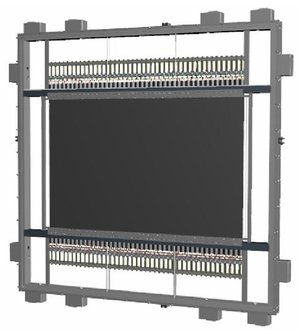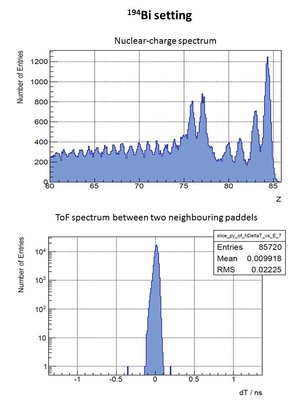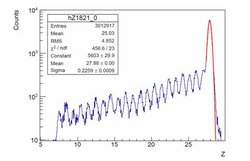New Time-of-Flight Wall TOFD
General Information
TOFD is the next-generation time-of-flight detector designed for R3B which will enable to fully exploit the potential of FAIR beams at the R3B setup - heavy beams up to 238U and high counting rates up to 1 MHz. This detector will be situated about 20 m down-stream of the reaction target, behind the large dipole magnet GLAD, and will measure the time-of-flight and the nuclear charge of the fragments produced in the target. Together with the measured trajectory through a dipole field, the mass of the fragments can be identified. The charge is obtained by precise energy loss measurements of the fragments passing through the detector.
In order to separate the neighbouring fragments in mass and atomic numbers also in the mass region 200 it is mandatory to reach a relative resolution in the energy-loss measurement σE/E better than 1% and in time-of-flight (TOF) measurement better than 2E-4. For a beam with 1AGeV kinetic energy and 20 m flight path, TOF has to be measured with a resolution better than σTOF = 20ps. Moreover, it will be necessary to maintain these values up to 1MHz beam rate.
The detector concept is based on the use of plastic scintillators. TOFD will have four planes of scintillators and the active part will cover an area of 120x80cm2. Each plane consists of 44 scintillator paddles with the size 800x27 mm2. The first two planes will have scintillators with a thickness of 3 mm and the last two planes a thickness of 5 mm, respectively. Each scintillator paddle will be directly coupled to photomultipliers on both far ends. The photomultipliers of choice have fully active base enabling that, even for large currents, the voltages at the last dynodes of the PMs could be kept constant and, consequently, the constant gain of the PM. This guarantees the stable peak position in the energy spectrum for different counting rates and, therefore, good energy resolution regardless on the counting rate. Moreover, the chosen electronic read-out allows extracting small currents/charges from the PMs which will furthermore guarantee stability of measurements even at the highest rates. The electronic readout is based on the new multichannel front-end electronic card TAMEX. This card has been designed by the GSI EE group for high-resolution time and charge measurements and is a combination of the existing LAND TACQUILA FEE and a FPGA TDC from the VFTX module.
More details can be found in the dedicated EPJA paper from M. Heil at al 10.1140/epja/s10050-022-00875-8.
Simulations of the achievable time resolution of the TOFD detector have been performed assuming three different scintillation materials. Simulations include: energy loss calculations with ATIMA, quenching of light production, scintillator raise and decay time, transport of light to the PMs, TTS of PMs, photoelectron threshold and electronic resolution. Three different scintillation materials have bee assumed: EJ200, EJ204 and EJ232. The results are presented in the table below, showing that the necessary resolution needed to separate neighbouring masses in different mass regions is achievable with the present design of the detector.
Fragment at 1AGeV | Needed sigma_t / ps | Predicted sigma_t / ps EJ200 | Predicted sigma_t / ps EJ204 | Measured sigma_t / ps EJ204 | Predicted sigma_t / ps EJ232 |
12C | 148 | 36 | 29 | 15 | |
56Fe | 39 | 25 | 21 | 17 | 11 |
132Sn | 20 | 20 | 17 | 10 | |
208Pb | 20 | 15 | 13 | 8 | 8 |
232U | 20 | 14 | 13 | 8 |
In 2014 during the S438 Experiment the prototype of the TOFD detector was tested with secondary beams in the Pb-U region. Preliminary results of the data analysis show that the design goals can be reached. As an example, results obtained with 194Bi entering the Cave C are shown in figure below: the nuclear-charge resolution of σZ=0.33 charge units (or equivalently 0.4%) and ToF resolution between two neighbouring paddles of 22 ps have been obtained. This ToF resolution corresponds to 8 ps of ToF resolution for the whole detector.
In the same experiment, the prototype of the TOFD detector has been tested with 58Ni at 500AMeV. With this light beam, we have measured a nuclear charge with a resolution of 0.8 % (sigma) which is the design goal. Measured time resolution of the full detector was 17 ps (sigma). This value is better than needed for this Kind of beam, see table above.
Lietarture
- "A new Time-of-flight detector for the R3B setup", M. Heil et al, The European physical journal / A 58(12), 248 (2022) [10.1140/epja/s10050-022-00875-8]
- "In-beam tests of a new ToF wall for the R3B setup", M. Heil et al, Scientific Report 2014 GSI Report 2015-1, 210-211 p. (2015) [10.15120/GR-2015-1-MU-NUSTAR-NR-16]
- "The in-beam tracking detectors of the R3B experiment", S. Paschalis et al, Scientific Report 2014 GSI Report 2015-1, 206-209 p. (2015) [10.15120/GR-2015-1-MU-NUSTAR-NR-15]
- "New time-of-flight system for the R3B set-up", A. Kelic-Heil et al, Scientific Report 2013 GSI Report 2014-1, 340-341 p. (2014) [10.15120/GR-2014-1-FG-S-FRS-06]
- "High precision multi-hit time-of-flight measurements at R3B", R. Plag et al, Scientific Report 2013 GSI Report 2014-1, 338-339 p. (2014) [10.15120/GR-2014-1-FG-S-FRS-05]
- "A new Time-of-flight wall for R3B", M. Heil et al, Scientific Report 2013 GSI Report 2014-1, 336-337 p. (2014) [10.15120/GR-2014-1-FG-S-FRS-04]
- "Heavy-ion tracking detectors for the R3B setup", S. Paschalis et al, Scientific Report 2013 GSI Report 2014-1, 147-149 p. (2014) [10.15120/GR-2014-1-NUSTAR-KR-10]






